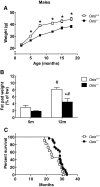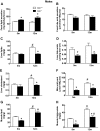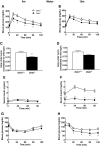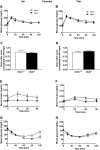Ostα-/- mice exhibit altered expression of intestinal lipid absorption genes, resistance to age-related weight gain, and modestly improved insulin sensitivity
- PMID: 24381083
- PMCID: PMC3949021
- DOI: 10.1152/ajpgi.00368.2013
Ostα-/- mice exhibit altered expression of intestinal lipid absorption genes, resistance to age-related weight gain, and modestly improved insulin sensitivity
Abstract
The organic solute transporter OSTα-OSTβ is a key transporter for the efflux of bile acids across the basolateral membrane of ileocytes and the subsequent return of bile acids to the liver. Ostα(-/-) mice exhibit reduced bile acid pools and impaired lipid absorption. In this study, wild-type and Ostα(-/-) mice were characterized at 5 and 12 mo of age. Ostα(-/-) mice were resistant to age-related weight gain, body fat accumulation, and liver and muscle lipid accumulation, and male Ostα(-/-) mice lived slightly longer than wild-type mice. Caloric intake and activity levels were similar for Ostα(-/-) and wild-type male mice. Fecal lipid excretion was increased in Ostα(-/-) mice, indicating that a defect in lipid absorption contributes to decreased fat accumulation. Analysis of genes involved in intestinal lipid absorption revealed changes consistent with decreased dietary lipid absorption in Ostα(-/-) animals. Hepatic expression of cholesterol synthetic genes was upregulated in Ostα(-/-) mice, showing that increased cholesterol synthesis partially compensated for reduced dietary cholesterol absorption. Glucose tolerance was improved in male Ostα(-/-) mice, and insulin sensitivity was improved in male and female Ostα(-/-) mice. Akt phosphorylation was measured in liver and muscle tissue from mice after acute administration of insulin. Insulin responses were significantly larger in male and female Ostα(-/-) than wild-type mice. These findings indicate that loss of OSTα-OSTβ protects against age-related weight gain and insulin resistance.
Keywords: bile acids; glucose tolerance; insulin sensitivity; lipid absorption; organic solute transporter.
Figures










References
-
- Bou Khalil M, Blais A, Figeys D, Yao Z. Lipin: the bridge between hepatic glycerolipid biosynthesis and lipoprotein metabolism. Biochim Biophys Acta 1801: 1249–1259, 2010 - PubMed
Publication types
MeSH terms
Substances
Grants and funding
- DK-40936/DK/NIDDK NIH HHS/United States
- ES-01247/ES/NIEHS NIH HHS/United States
- U24 DK059635/DK/NIDDK NIH HHS/United States
- R37 DK025636/DK/NIDDK NIH HHS/United States
- U24 DK-076169/DK/NIDDK NIH HHS/United States
- DK-067214/DK/NIDDK NIH HHS/United States
- P30 DK034989/DK/NIDDK NIH HHS/United States
- T32 ES007026/ES/NIEHS NIH HHS/United States
- DK-34989/DK/NIDDK NIH HHS/United States
- DK-19974/DK/NIDDK NIH HHS/United States
- ES-070236/ES/NIEHS NIH HHS/United States
- DK-25636/DK/NIDDK NIH HHS/United States
- P30 ES001247/ES/NIEHS NIH HHS/United States
LinkOut - more resources
Full Text Sources
Other Literature Sources
Medical
Molecular Biology Databases

